What Are Purple Hull Peas And What's The Best Way To Cook Them?
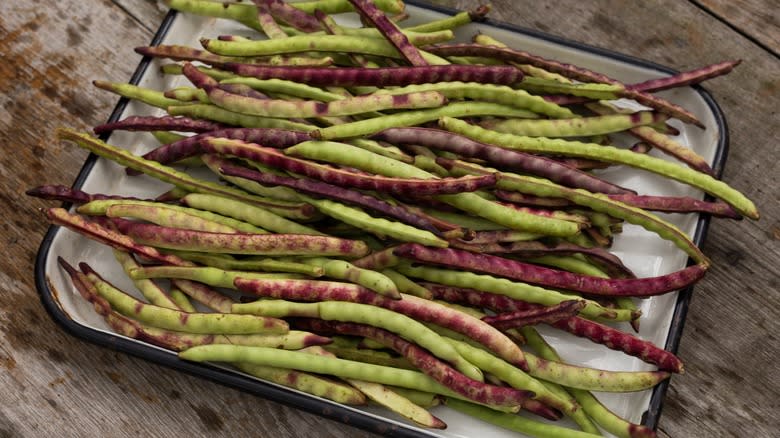
In the heart of the American South, there lies a cherished culinary gem: the purple hull pea. This unassuming legume, with its tender seeds nestled within vibrant purple pods, holds a special place in Southern cuisine and culture. Likely brought to the U.S. by enslaved people from Africa, where they have been commonly eaten for thousands of years, purple hull peas became a popular crop for feeding both humans and livestock.
This resilient plant is well-suited to the Southern climate, thriving in warm weather and well-drained soils. It is a favorite among home gardeners in the South, not only for its delicious yield but also for its ability to enrich the soil with nitrogen, enhancing overall soil health.
In the kitchen, purple hull peas are incredibly versatile and can be prepared in various ways to suit a range of tastes. One of the most popular methods of cooking purple hull peas is to simmer them with flavorful ingredients such as bacon, ham hocks, or sausage. This process infuses the peas with rich, savory flavors, creating a delectable dish that is often served over a bed of fluffy rice or cornbread.
Read more: 13 Simple Tricks To Pick The Best Fresh Fruit Every Time
What Are Purple Hull Peas?
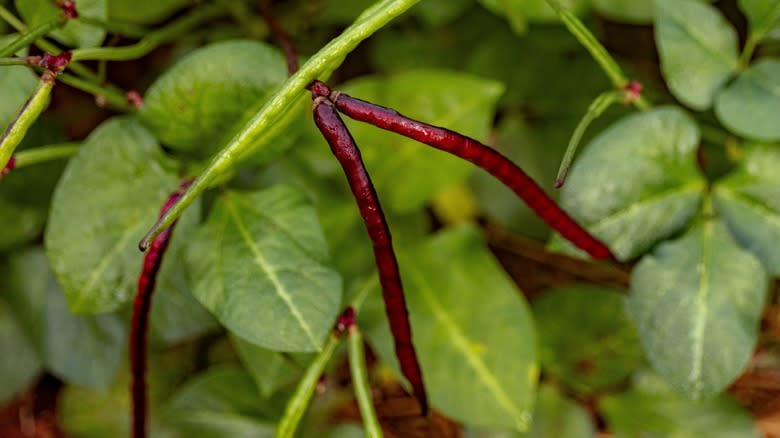
Purple hull peas, often referred to simply as "purple hulls," are a cultivated variety within the larger cowpea or southern pea group, which also includes the more ubiquitous black-eyed pea. The scientific name for the cowpea is Vigna unguiculata, and its specific epithet, "unguiculata," translates to "having a small claw," which aptly describes the species' stalked flower petals. The plant's edible pods, which occur in varying shades of green and purple, house the vibrant peas -- small, oval seeds that range from green to tan to light pink. Purple hull peas are a creamy, pale green with a purple to pink spot or eye, which has earned them their alternate name: pink-eyed peas.
These peas are typically harvested in late spring through summer, presenting a seasonal delicacy that many eagerly anticipate. The harvesting process involves removing the peas from their distinctive purple pods, revealing the beautiful seeds within. The act of shelling purple hull peas is historically a communal activity. Families and communities often come together during the harvest season to share stories, laughter, and the joy of preparing and enjoying a meal featuring these cherished legumes. With their unique appearance, delightful flavor, and rich nutritional profile, they have earned a prominent place in both home kitchens and renowned Southern eateries.
Purple Hull Peas Vs. Black-Eyed Peas
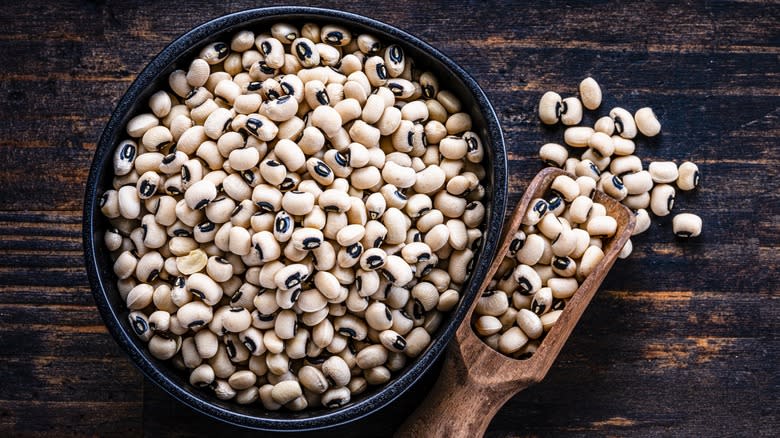
In the realm of Southern cuisine, legumes hold a special place, and two beloved varieties often take center stage -- purple hull peas and black-eyed peas (pictured). While both are treasured staples, they have distinct differences in appearance and flavor profiles that set them apart.
The most apparent distinction between purple hull peas and black-eyed peas lies in their appearance. Purple hull peas, as their name suggests, have elongated pods that showcase vibrant hues of green and purple. Upon shelling, they reveal round speckled peas that are primarily a pale green color. On the other hand, black-eyed peas have green pods containing distinctive bright white beans with a creamy texture and a dark black spot or "eye" on the surface, giving them their name.
In terms of taste and texture, purple hull peas have a slightly nuttier, creamier flavor compared to black-eyed peas. They are often considered more tender and have a sweeter taste, making them a preferred choice for those who enjoy a milder legume. Conversely, black-eyed peas have a creamy texture with a slightly stronger, more noticeable flavor.
What Do Purple Hull Peas Taste Like?
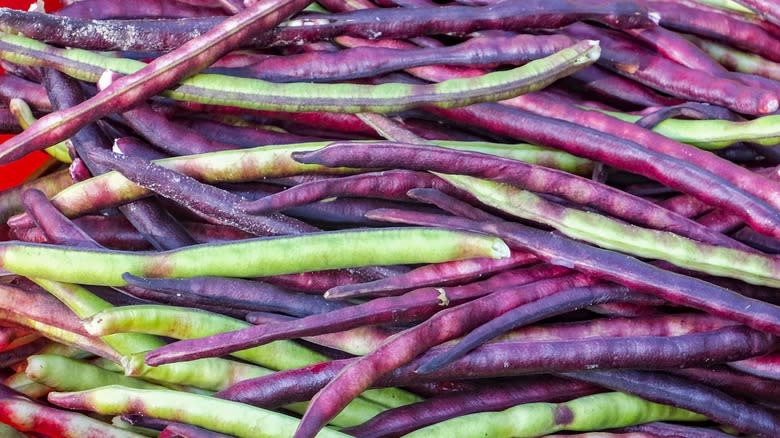
The flavor of purple hull peas is a blend of subtle nuttiness, earthiness, and a hint of sweetness. When prepared and cooked, they have a tender and slightly creamy texture that adds to their overall appeal. The unique taste of purple hull peas sets them apart from other beans, making them a favorite in the American South.
One of the defining aspects of the flavor profile of purple hull peas is their nutty essence. As you take a bite, you'll notice a gentle, nut-like undertone that adds a layer of richness and depth to the overall taste. Purple hull peas also possess earthy undertones, which contribute to their distinct taste. This earthiness evokes a sense of connection to the land, reminding us of their rich history in Southern soils. It's a grounding flavor that pairs exceptionally well with other ingredients often used in Southern cooking, creating a comforting and satisfying culinary experience.
Adding to the complexity of their flavor, purple hull peas also boast a subtle sweetness that balances the nutty and earthy tones. This touch of sweetness enhances their appeal, making them an excellent complement to a wide range of dishes. The sweetness is not overpowering but rather a gentle note that rounds out the overall taste profile.
How To Cook Purple Hull Peas
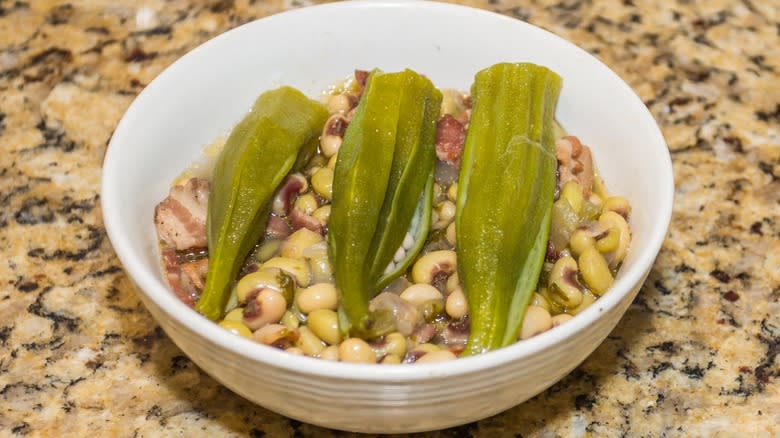
Legumes are typically best enjoyed cooked. Cooking with purple hull peas also allows you to unlock their full potential and create a variety of flavorful dishes. Possibly the most basic way of cooking them is to simmer them with an accompaniment of flavorful ingredients. Put the peas in a pot with stock or water to cover them by a few inches, then add chunks of onion, whole or sliced garlic cloves, smoked cured ham hock, salt, and pepper, and bring it to a boil. Lower the heat and allow the purple hull peas to simmer for 45 minutes to an hour to enable them to soak up the water and soften, adding more water if the pot gets too dry. If a plant-based approach is desired, simply swap out the stock for vegetable stock and omit the ham hock.
Purple hull peas cooked thusly can be eaten as is or with rice or cornbread for a bit of starch. The peas can also be used in much the same way as their close cousins, such as in the classic Southern black-eyed pea-based New Year's Day dish Hoppin' John. For this, sauté "the Cajun trinity" -- bell pepper, celery, and onion -- along with garlic and bacon in a pot, before adding in soaked or fresh purple hull peas and simmering as you would for the above preparation. Ham hock can also be used here but isn't mandatory as there is already bacon. Once the beans are cooked through, drain them and serve with rice.
Where To Buy Purple Hull Peas
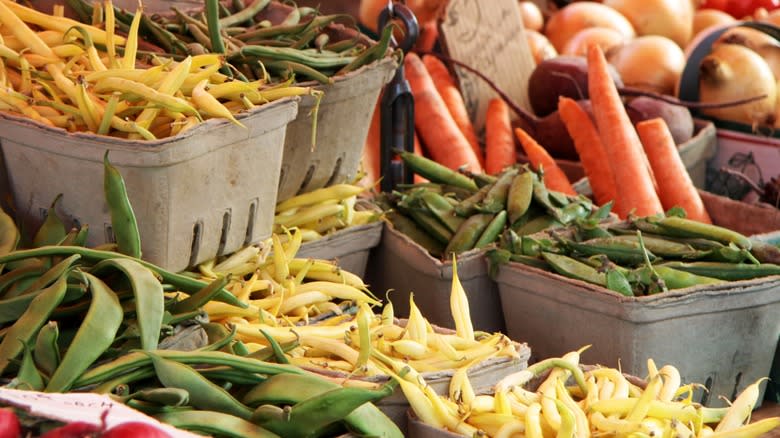
You're probably saying to yourself, "I've never seen purple hull peas in my grocery store," and that is likely true, albeit it depends on where you live. In the northern and western U.S., they aren't as widely known and thus aren't as widely distributed. Even in the South, given the homogenization of foodways, they can be a bit of a specialty item. But that doesn't mean you have to go to any great lengths to obtain them.
If you're lucky enough to live in an area where they are commonly grown, then you may find purple hull peas at grocery stores and farmers markets during the summer harvesting season. These will typically be sold in the pod, so you'll have to shell them yourself. As we've stated, this is typically a community affair so gather some friends for the fun.
The best option for most people is to go online. There are a plethora of options for buying purple hull peas virtually, but, unlike their more common counterpart, the black-eyed pea, they are generally sold frozen rather than dried. This is actually a benefit as the flash-freezing used right at the moment of harvesting preserves much of the purple hull peas' natural flavor and nutrients. They're also widely available canned, both in stores and online, which means they are already cooked. While this isn't outright a bad thing, it does mean that recipes will have to be adjusted accordingly -- and much of the toothsome bite of the fresh or frozen peas will be lost.
Nutritional Value Of Purple Hull Peas
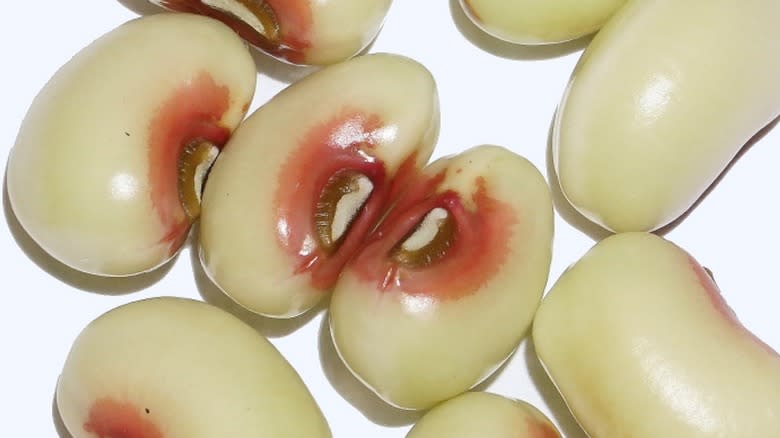
As you might imagine, considering that they are legumes, purple hull peas are quite nutritious. They are a wonderful source of fiber, which the Mayo Clinic notes is important for maintaining strong gut health, keeping digestion regular, and lowering cholesterol. Fiber also promotes a feeling of fullness, which, when combined with the purple hull peas' low caloric count by weight, can help people who are seeking to lose weight move towards their goal.
According to Healthline, protein is one of the most important nutrients our bodies need to build muscle and repair tissues. Each half cup of purple hull peas contains around 6 grams of protein, roughly equal to the amount of protein found in an egg. And, if you're looking for energy, they have their black-eyed cousins beat, with an impressive 19 grams of carbohydrates per half cup.
Purple hull peas also feature a range of beneficial vitamins and minerals. When compared to many other vegetables, they contain high levels of folate, vitamin A, potassium, and calcium, making them a great addition to a balanced, vegetable-forward diet.
How To Store Purple Hull Peas
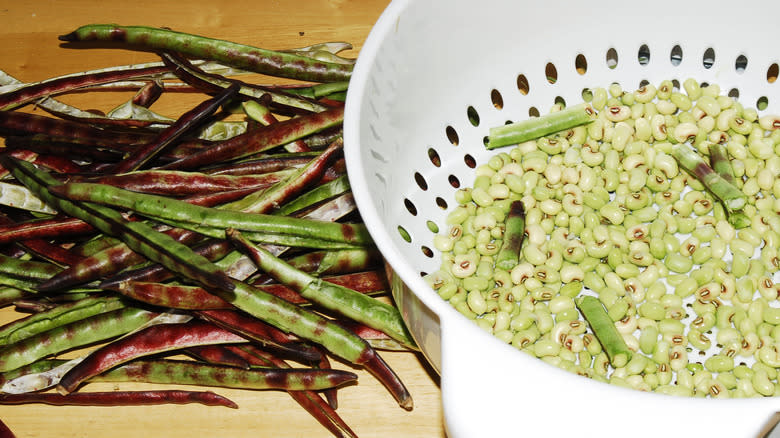
We'll start here with the obvious, which is that purple hull peas purchased frozen should be kept frozen until you're ready to use them. The same thing goes for safely storing canned and dried peas in a cool, dry location. But fresh purple hull peas are, like other legumes and vegetables, a bit more perishable. So, if you're growing them yourself or have purchased some fresh pods, there are a few guidelines to follow to ensure that you'll be enjoying your harvest for as long as possible.
First, you'll want to wash the purple hull peas in a few changes of water to make sure that they're thoroughly clean. Then, toss them into a pot of boiling water to blanch them. When the water returns to a boil, skim off any foam that rises to the top, and allow the purple hull peas to boil for three to four minutes. Next, remove them and shock them in an ice-water bath to halt the cooking process. Once they have cooled, drain them completely and place them into freezer bags or other freezer-safe containers. If you guessed that the next step is to freeze your fresh haul until you're ready to use it, you are indeed astute. Your cooked and frozen peas will last up to six months in the freezer.
Varieties Of Purple Hull Peas
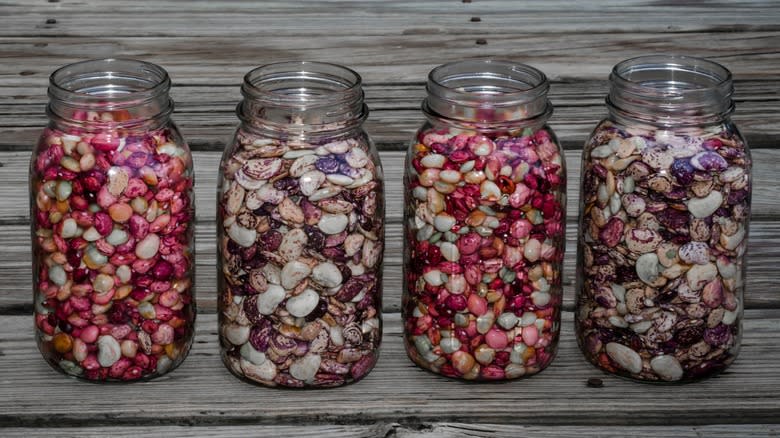
Purple hull peas are themselves a variety of legume, specifically, they are members of the informal southern pea group that also includes the well-known black-eyed peas as well as crowder peas, conch peas, and more. But that doesn't mean there aren't additional varieties within the subgrouping of purple hull peas.
Big Boy peas are a popular variety believed to have originated in Texas. The vines stand tall and produce easy-to-pick pods, making them a favorite among gardeners. Coronet peas are part of the Pinkeye Purple Hull pea grouping and were bred at the University of Georgia to be resistant to common mosaic viruses that can destroy pea crops. Meanwhile, Knuckle Purple peas, bred by the Alabama Agricultural Experiment Station, have a high yield and do quite well either canned or dried.
Hailing from Mississippi and prized for being resistant to nematodes, bacteria, and wilt that commonly affect southern peas, Mississippi Purples are quite easy to shell. Similarly, Pinkeye Purple Hull BVR peas could be described as cooperative as they mature early and shoot their pods above the rest of the plant which makes picking quite a bit easier. Other varieties include CT Pinkeye, Early Scarlet, and Quickpick Pinkeye.
Read the original article on Tasting Table.

